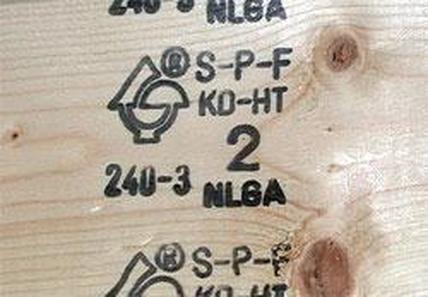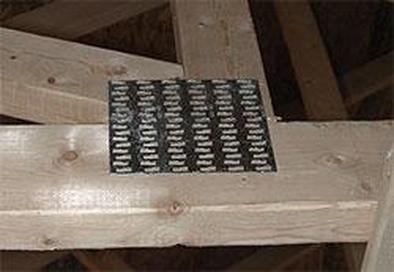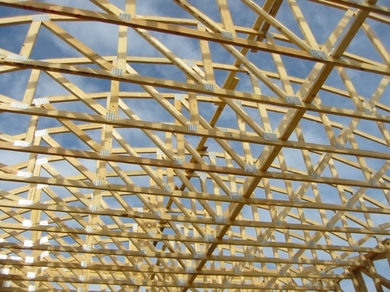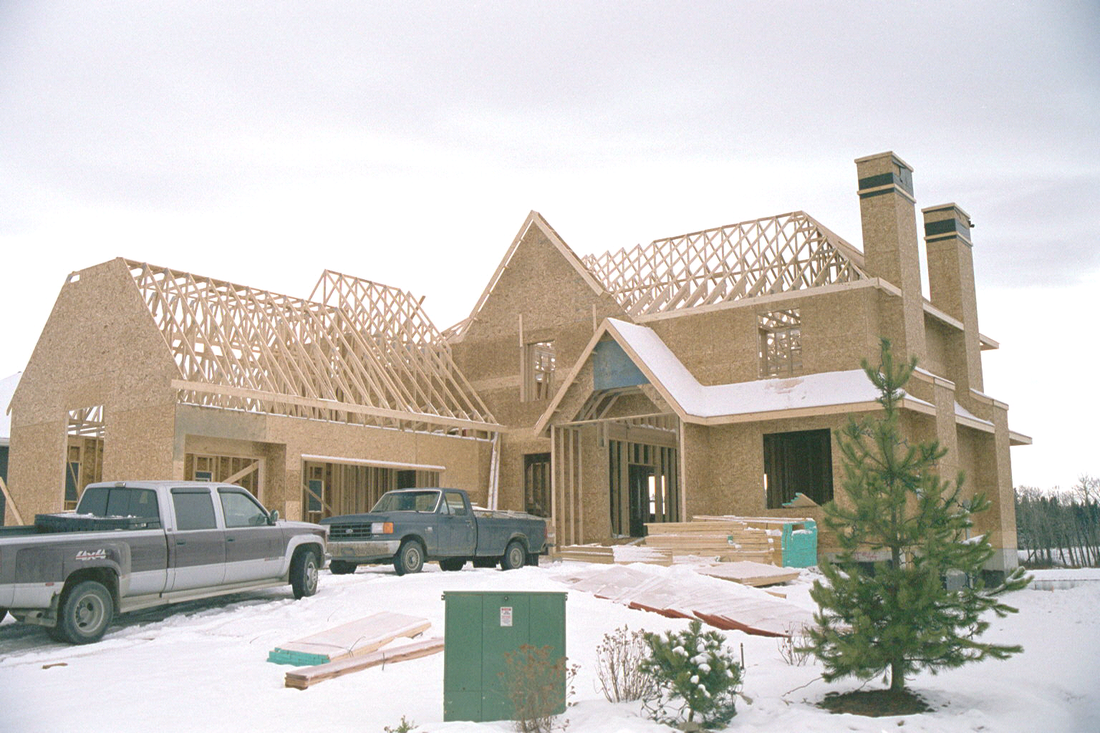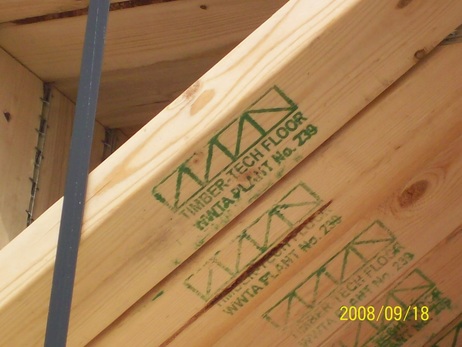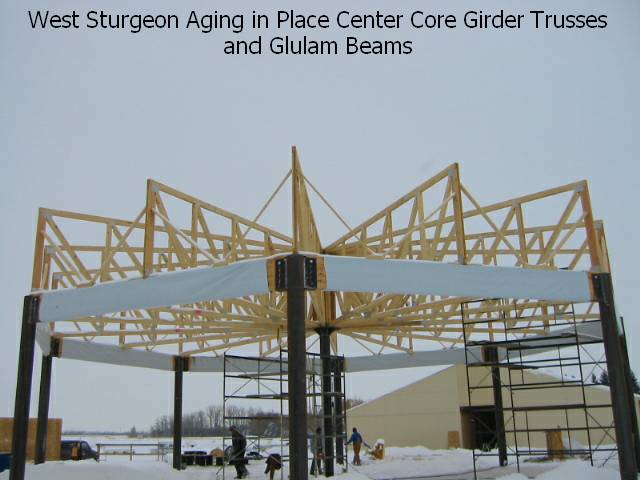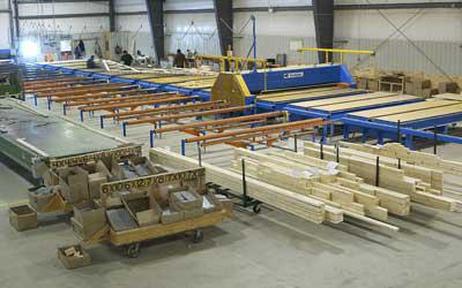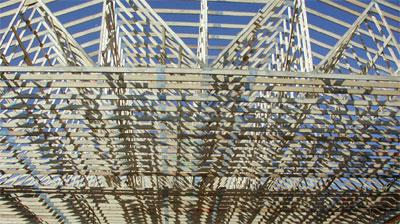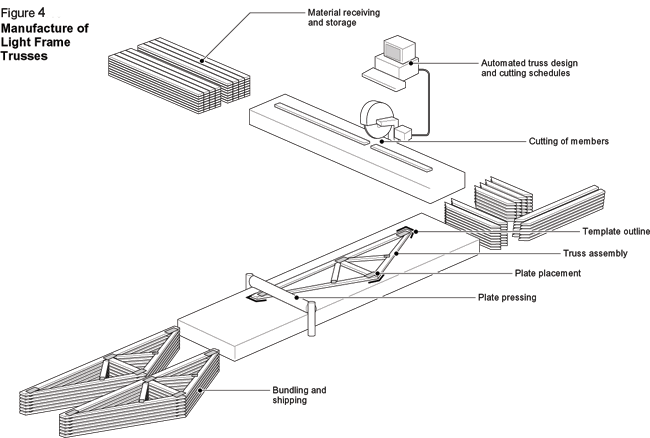Material
|
Lumber
Most trusses are fabricated using visually graded lumber and machine stress-rated lumber. Visual grades used in chords will include Select Structural, No.1/No.2, whereas webs can also use No. 3 and Stud grades. When calculated stresses and truss configurations require greater strength qualities machine stress-rated lumber is used. Trusses are fabricated using 38 x 64mm to 38 x 286mm lumber according to loading and truss spacing. All trusses for use in Canada must be manufactured using NLGA graded lumber that have assigned structural properties listed in CSA O86-14 |
Plates
Today, almost all light frame trusses are connected by means of galvanized steel plates referred to commonly as truss plates or connector plates. The plates are manufactured by high speed stamping machines that punch out the plate teeth, and shear the plate to required size. Many sizes and gauges of connector plates are manufactured to suit a variety of joint geometries and loadings. The use of metal plates permits the plant fabrication of trusses with consistent and dependable engineering properties.
Today, almost all light frame trusses are connected by means of galvanized steel plates referred to commonly as truss plates or connector plates. The plates are manufactured by high speed stamping machines that punch out the plate teeth, and shear the plate to required size. Many sizes and gauges of connector plates are manufactured to suit a variety of joint geometries and loadings. The use of metal plates permits the plant fabrication of trusses with consistent and dependable engineering properties.
How Trusses are made and Quality Assurance
|
The metal connector plate transfers loads between adjoining members through the connector plate teeth. The connector plate strength is dependent on the grip of the teeth and the shear and tensile capacity of the steel plate. The plate is prevented from deforming during installation, and the minimum tooth penetration must be maintained, as monitored by the manufacturer's quality assurance personnel. Each plate must be installed using specifically designed press or roller truss plate equipment to achieve published design values as per CCMC reports. Truss plates that are available to the public through retail outlets or those used by related industries in packaging & pallets will perform to published values only if installed correctly.
In Canada truss plates are usually stamped from 16, 18 or 20 gauge (US Standard Gauge) sheet steel of minimum quality as prescribed in the 2001 edition of CSA Standard O86-01, Engineering Design in Wood. Truss plates are proprietary products approved by the Canadian Centre for Materials in Construction (CCMC) each with a unique set of design values. In order to obtain approval, the plates are tested in accordance with CSA Standard S347-M1980 Method of Test for Evaluation of Truss Plates Used in Lumber Joints. Plate widths can be from 25mm (1") to 300mm (12") and lengths can be up to 600mm (2') or even longer. Stamping results in teeth lengths varying from about 6mm (1/4") to 25mm (1"). Nail-on plates are occasionally provided to allow assembly by the builder on the site. For example, nail on plates are sometimes used to join separate parts of a field-assembled truss. |
|
Manufacturing
The computer design of light frame trusses results in the generation of fabrication instructions that indicate the precise cutting patterns for each of the members and the type, size, and location of connector plates required. A layout template is made for each configuration to ensure that like trusses are identical in dimension. The member pieces are cut to correct dimension and assembled in the template, which is located on a floor, truss jig, or heavy table. The cutting drawings show a sketch of the truss and contain the following important information: -overall truss dimensions -location of all supports -web and chord sizes and grades -plate size, type, and location for each joint The chords and webs are connected together by the use of truss plates, which transfer the tensile, compressive and shear forces. Identical truss plates are placed directly opposite each other on opposing faces and are pressed into the wood members using hydraulic platen (plates) presses or rollers. When the pressing of the plates has been completed, the trusses are checked for dimensions, wood to wood gaps, lumber size and species, plate size, positioning and embedment and moved to a storage area. In some cases plants have a quality control program that ensures consistency in production and quality in place of checking each truss. The completed trusses are then strapped together and placed in the storage yard in preparation for shipping. |
Design Procedures
The truss design is initiated by the builder or owner, or his designate; i.e. the general contractor or architect/engineer. The documentation must include: -the size of the building, -the building occupancy, -the shape and span of the truss, -where the truss will be supported, -the type of roof construction (finish, insulation, sheeting, ceiling type) -what the loads on the truss will be special requirements to be considered in truss design such as special loading and placement geometry defining parameters (pitches, heel heights, overhang and cantilever details) For more details on the design responsibilities of the truss designer and the building designer consult the TPIC design procedures page iii. Typically, the building designer or builder will contract with the truss fabricator, who will supply a truss layout and a structural design of each significant element of the roof system. The truss plate manufacturer's engineer usually reviews and seals the individual truss designs on behalf of the truss fabricator. In North America, designs are based on structural requirements from Building Codes using design standards referenced in Building Codes and approved material properties: -Structural analogues and methodology have been developed and standardized by National Associations such as TPIC in Canada and TPI in the United States who represent the manufacturers of metal plate connectors. -Lumber design values for use in Canada are published by Canadian StandardsAssociation (CSA 086-Engineering Design in Wood). -Truss connector plates are proprietary and therefore come with different structural properties. Design values for truss plates are developed through tests and analyses in accordance with referenced standards. Approval of the design values is overseen by national certification organizations such as the Canadian Construction Materials Centre (CCMC). Preliminary discussion of a design with a truss fabricator may result in suggestions leading to the most efficient and the most cost effective design. Truss design is facilitated by the use of computer software that designs all members, connections and produces a design drawing for an engineer's approval and also shop drawings and cutting lists for manufacturing and quality control. The approval and acceptance process of truss design drawings depends on local requirements. In most jurisdictions, a professional engineer's stamp on the truss design drawing may be compulsory. In other cases alternate procedures may be acceptable. |

